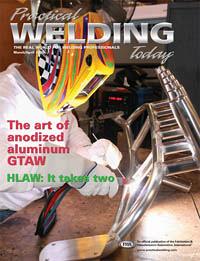President
- FMA
- The Fabricator
- FABTECH
- Canadian Metalworking
Categories
- Additive Manufacturing
- Aluminum Welding
- Arc Welding
- Assembly and Joining
- Automation and Robotics
- Bending and Forming
- Consumables
- Cutting and Weld Prep
- Electric Vehicles
- En Español
- Finishing
- Hydroforming
- Laser Cutting
- Laser Welding
- Machining
- Manufacturing Software
- Materials Handling
- Metals/Materials
- Oxyfuel Cutting
- Plasma Cutting
- Power Tools
- Punching and Other Holemaking
- Roll Forming
- Safety
- Sawing
- Shearing
- Shop Management
- Testing and Measuring
- Tube and Pipe Fabrication
- Tube and Pipe Production
- Waterjet Cutting
Industry Directory
Webcasts
Podcasts
FAB 40
Advertise
Subscribe
Account Login
Search
Aluminum Workshop: How to age aluminum when welding in T6
- By Frank Armao
- Updated August 8, 2023
- March 24, 2009
- Article
- Aluminum Welding
Q: In the last Aluminum Workshop, you talked about improving the welded strength of 6061 by welding in the T4 temper and aging after welding. But what happens if we weld in the T6 temper and age after welding? Does the weld get stronger, or does the extra aging cycle overage the T6 base material and make it weaker?
A: First, let's define what an aging cycle is. The two common aging cycles for 6061 are 400 degrees F for one hour or 350 degrees F for four hours—both will result in the same mechanical properties of the aged 6061-T6. If you weld 6061-T6 and then age it using either of these aging cycles, the transverse tensile properties of the weld actually increase slightly, but not much—only 1 or 2 KSI.
Strength When Aging Aluminum
Why does the strength increase? During welding the HAZ is subjected to various thermal cycles, depending on how far it is from the fusion line. Part of the HAZ is actually re-solution-heat-treated by the welding. So when we age the weld in the T6 material, this part of the HAZ actually increases in tensile strength.
So why doesn't the extra aging cycle overage the 6061-T6 parent material and make it weaker? In some aluminum alloys it would. For such alloys, exposure to an extra aging cycle would overage them and reduce the strength of the parent material. However, the 6XXX alloys like 6061 and 6063 have a relatively flat aging curve. That is to say, while the T4 properties rise quickly on exposure to the elevated aging temperature, they don't fall off quickly. So exposing welds in 6061-T6 or 6063-T6 to an extra aging cycle doesn't reduce the strength of the base material at all and actually increases the strength of the HAZ a bit. Is the small improvement in tensile strength worth the cost of the extra aging cycle? That's up to you.
About the Author

Frank Armao
Aluminum Consulting Inc.
440-479-0239
About the Publication
Related Companies
subscribe now

The Welder, formerly known as Practical Welding Today, is a showcase of the real people who make the products we use and work with every day. This magazine has served the welding community in North America well for more than 20 years.
start your free subscription- Stay connected from anywhere

Easily access valuable industry resources now with full access to the digital edition of The Fabricator.

Easily access valuable industry resources now with full access to the digital edition of The Welder.

Easily access valuable industry resources now with full access to the digital edition of The Tube and Pipe Journal.
- Podcasting
- Podcast:
- The Fabricator Podcast
- Published:
- 04/16/2024
- Running Time:
- 63:29
In this episode of The Fabricator Podcast, Caleb Chamberlain, co-founder and CEO of OSH Cut, discusses his company’s...
- Industry Events
16th Annual Safety Conference
- April 30 - May 1, 2024
- Elgin,
Pipe and Tube Conference
- May 21 - 22, 2024
- Omaha, NE
World-Class Roll Forming Workshop
- June 5 - 6, 2024
- Louisville, KY
Advanced Laser Application Workshop
- June 25 - 27, 2024
- Novi, MI
































